Zenan Xu
Adaptive Termination for Multi-round Parallel Reasoning: An Universal Semantic Entropy-Guided Framework
Jul 09, 2025Abstract:Recent advances in large language models (LLMs) have accelerated progress toward artificial general intelligence, with inference-time scaling emerging as a key technique. Contemporary approaches leverage either sequential reasoning (iteratively extending chains of thought) or parallel reasoning (generating multiple solutions simultaneously) to scale inference. However, both paradigms face fundamental limitations: sequential scaling typically relies on arbitrary token budgets for termination, leading to inefficiency or premature cutoff; while parallel scaling often lacks coordination among parallel branches and requires intrusive fine-tuning to perform effectively. In light of these challenges, we aim to design a flexible test-time collaborative inference framework that exploits the complementary strengths of both sequential and parallel reasoning paradigms. Towards this goal, the core challenge lies in developing an efficient and accurate intrinsic quality metric to assess model responses during collaborative inference, enabling dynamic control and early termination of the reasoning trace. To address this challenge, we introduce semantic entropy (SE), which quantifies the semantic diversity of parallel model responses and serves as a robust indicator of reasoning quality due to its strong negative correlation with accuracy...
Hunyuan-TurboS: Advancing Large Language Models through Mamba-Transformer Synergy and Adaptive Chain-of-Thought
May 21, 2025Abstract:As Large Language Models (LLMs) rapidly advance, we introduce Hunyuan-TurboS, a novel large hybrid Transformer-Mamba Mixture of Experts (MoE) model. It synergistically combines Mamba's long-sequence processing efficiency with Transformer's superior contextual understanding. Hunyuan-TurboS features an adaptive long-short chain-of-thought (CoT) mechanism, dynamically switching between rapid responses for simple queries and deep "thinking" modes for complex problems, optimizing computational resources. Architecturally, this 56B activated (560B total) parameter model employs 128 layers (Mamba2, Attention, FFN) with an innovative AMF/MF block pattern. Faster Mamba2 ensures linear complexity, Grouped-Query Attention minimizes KV cache, and FFNs use an MoE structure. Pre-trained on 16T high-quality tokens, it supports a 256K context length and is the first industry-deployed large-scale Mamba model. Our comprehensive post-training strategy enhances capabilities via Supervised Fine-Tuning (3M instructions), a novel Adaptive Long-short CoT Fusion method, Multi-round Deliberation Learning for iterative improvement, and a two-stage Large-scale Reinforcement Learning process targeting STEM and general instruction-following. Evaluations show strong performance: overall top 7 rank on LMSYS Chatbot Arena with a score of 1356, outperforming leading models like Gemini-2.0-Flash-001 (1352) and o4-mini-2025-04-16 (1345). TurboS also achieves an average of 77.9% across 23 automated benchmarks. Hunyuan-TurboS balances high performance and efficiency, offering substantial capabilities at lower inference costs than many reasoning models, establishing a new paradigm for efficient large-scale pre-trained models.
GraphLoRA: Empowering LLMs Fine-Tuning via Graph Collaboration of MoE
Dec 18, 2024Abstract:Low-Rank Adaptation (LoRA) is a parameter-efficient fine-tuning method that has been widely adopted in various downstream applications of LLMs. Together with the Mixture-of-Expert (MoE) technique, fine-tuning approaches have shown remarkable improvements in model capability. However, the coordination of multiple experts in existing studies solely relies on the weights assigned by the simple router function. Lack of communication and collaboration among experts exacerbate the instability of LLMs due to the imbalance load problem of MoE. To address this issue, we propose a novel MoE graph-based LLM fine-tuning framework GraphLoRA, in which a graph router function is designed to capture the collaboration signals among experts by graph neural networks (GNNs). GraphLoRA enables all experts to understand input knowledge and share information from neighbor experts by aggregating operations. Besides, to enhance each expert's capability and their collaborations, we design two novel coordination strategies: the Poisson distribution-based distinction strategy and the Normal distribution-based load balance strategy. Extensive experiments on four real-world datasets demonstrate the effectiveness of our GraphLoRA in parameter-efficient fine-tuning of LLMs, showing the benefits of facilitating collaborations of multiple experts in the graph router of GraphLoRA.
Learning Summary-Worthy Visual Representation for Abstractive Summarization in Video
May 08, 2023Abstract:Multimodal abstractive summarization for videos (MAS) requires generating a concise textual summary to describe the highlights of a video according to multimodal resources, in our case, the video content and its transcript. Inspired by the success of the large-scale generative pre-trained language model (GPLM) in generating high-quality textual content (e.g., summary), recent MAS methods have proposed to adapt the GPLM to this task by equipping it with the visual information, which is often obtained through a general-purpose visual feature extractor. However, the generally extracted visual features may overlook some summary-worthy visual information, which impedes model performance. In this work, we propose a novel approach to learning the summary-worthy visual representation that facilitates abstractive summarization. Our method exploits the summary-worthy information from both the cross-modal transcript data and the knowledge that distills from the pseudo summary. Extensive experiments on three public multimodal datasets show that our method outperforms all competing baselines. Furthermore, with the advantages of summary-worthy visual information, our model can have a significant improvement on small datasets or even datasets with limited training data.
Modeling Semantic Composition with Syntactic Hypergraph for Video Question Answering
May 13, 2022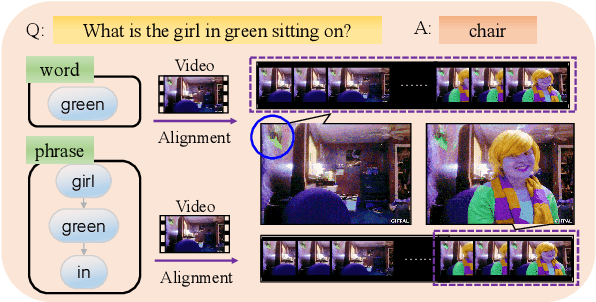
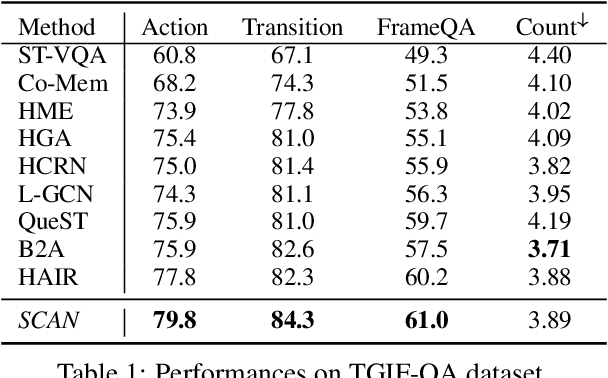
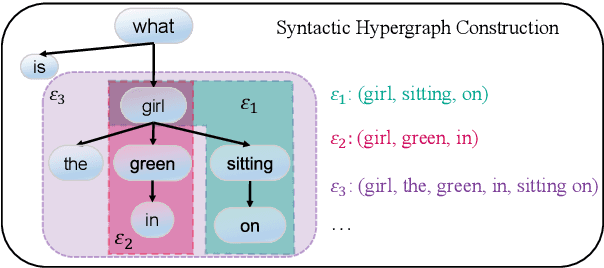
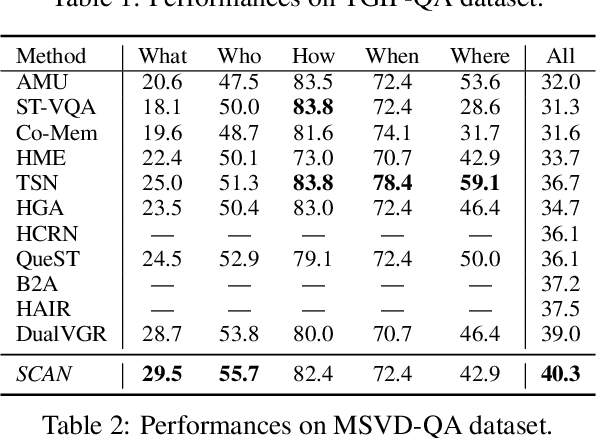
Abstract:A key challenge in video question answering is how to realize the cross-modal semantic alignment between textual concepts and corresponding visual objects. Existing methods mostly seek to align the word representations with the video regions. However, word representations are often not able to convey a complete description of textual concepts, which are in general described by the compositions of certain words. To address this issue, we propose to first build a syntactic dependency tree for each question with an off-the-shelf tool and use it to guide the extraction of meaningful word compositions. Based on the extracted compositions, a hypergraph is further built by viewing the words as nodes and the compositions as hyperedges. Hypergraph convolutional networks (HCN) are then employed to learn the initial representations of word compositions. Afterwards, an optimal transport based method is proposed to perform cross-modal semantic alignment for the textual and visual semantic space. To reflect the cross-modal influences, the cross-modal information is incorporated into the initial representations, leading to a model named cross-modality-aware syntactic HCN. Experimental results on three benchmarks show that our method outperforms all strong baselines. Further analyses demonstrate the effectiveness of each component, and show that our model is good at modeling different levels of semantic compositions and filtering out irrelevant information.
AR-LSAT: Investigating Analytical Reasoning of Text
Apr 15, 2021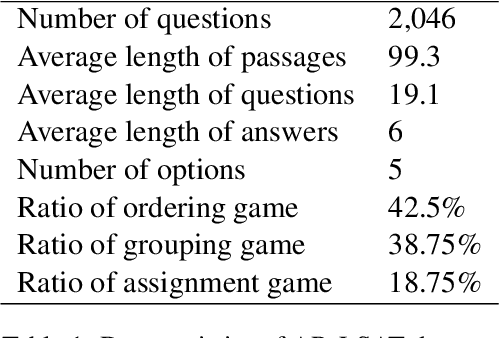
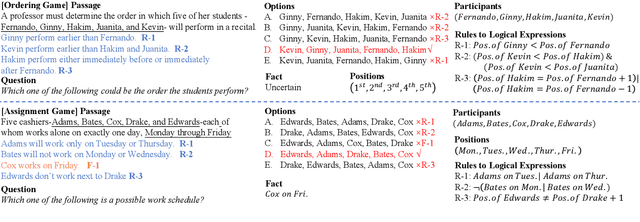


Abstract:Analytical reasoning is an essential and challenging task that requires a system to analyze a scenario involving a set of particular circumstances and perform reasoning over it to make conclusions. In this paper, we study the challenge of analytical reasoning of text and introduce a new dataset consisting of questions from the Law School Admission Test from 1991 to 2016. We analyze what knowledge understanding and reasoning abilities are required to do well on this task. Furthermore, to address this reasoning challenge, we design two different baselines: (1) a Transformer-based method which leverages the state-of-the-art pre-trained language models and (2) Analytical Reasoning Machine (ARM), a logical-level reasoning framework extracting symbolic knowledge (e.g, participants, facts, logical functions) to deduce legitimate solutions. In our experiments, we find that the Transformer-based models struggle to solve this task as their performance is close to random guess and ARM achieves better performance by leveraging symbolic knowledge and interpretable reasoning steps. Results show that both methods still lag far behind human performance, which leave further space for future research.
Syntax-Enhanced Pre-trained Model
Dec 28, 2020

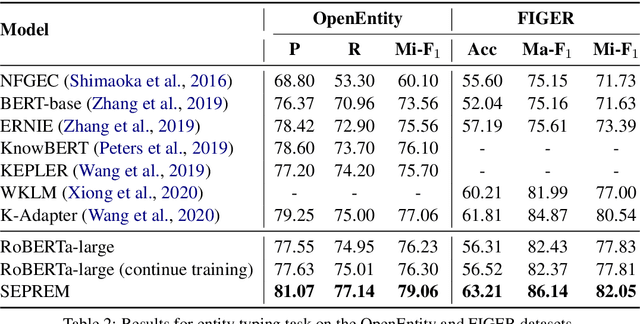

Abstract:We study the problem of leveraging the syntactic structure of text to enhance pre-trained models such as BERT and RoBERTa. Existing methods utilize syntax of text either in the pre-training stage or in the fine-tuning stage, so that they suffer from discrepancy between the two stages. Such a problem would lead to the necessity of having human-annotated syntactic information, which limits the application of existing methods to broader scenarios. To address this, we present a model that utilizes the syntax of text in both pre-training and fine-tuning stages. Our model is based on Transformer with a syntax-aware attention layer that considers the dependency tree of the text. We further introduce a new pre-training task of predicting the syntactic distance among tokens in the dependency tree. We evaluate the model on three downstream tasks, including relation classification, entity typing, and question answering. Results show that our model achieves state-of-the-art performance on six public benchmark datasets. We have two major findings. First, we demonstrate that infusing automatically produced syntax of text improves pre-trained models. Second, global syntactic distances among tokens bring larger performance gains compared to local head relations between contiguous tokens.
Neural Deepfake Detection with Factual Structure of Text
Oct 15, 2020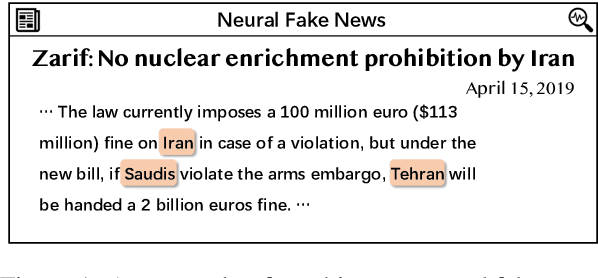
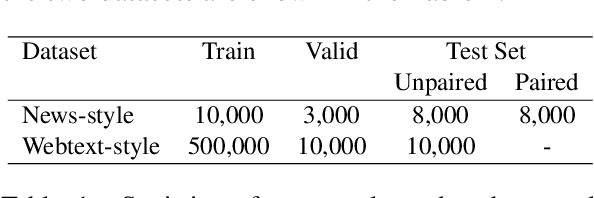
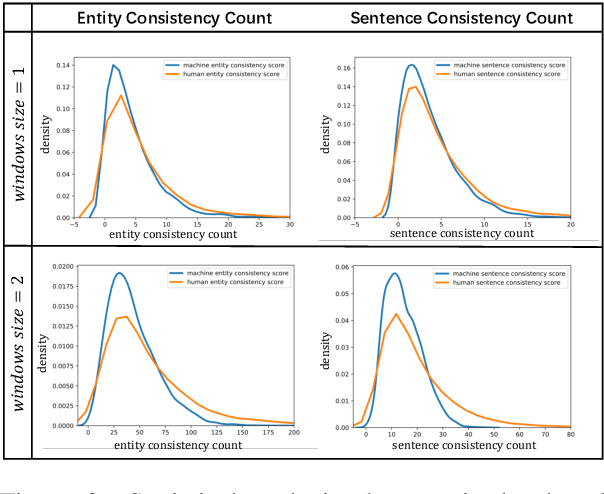
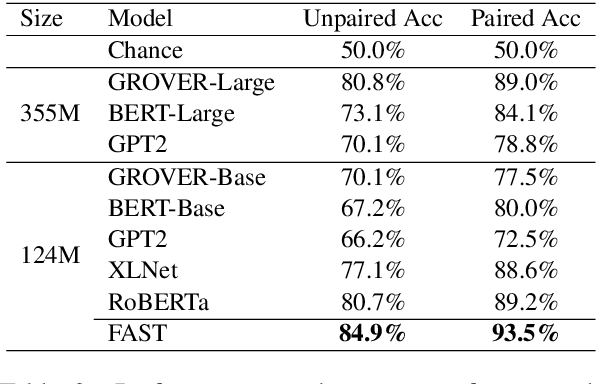
Abstract:Deepfake detection, the task of automatically discriminating machine-generated text, is increasingly critical with recent advances in natural language generative models. Existing approaches to deepfake detection typically represent documents with coarse-grained representations. However, they struggle to capture factual structures of documents, which is a discriminative factor between machine-generated and human-written text according to our statistical analysis. To address this, we propose a graph-based model that utilizes the factual structure of a document for deepfake detection of text. Our approach represents the factual structure of a given document as an entity graph, which is further utilized to learn sentence representations with a graph neural network. Sentence representations are then composed to a document representation for making predictions, where consistent relations between neighboring sentences are sequentially modeled. Results of experiments on two public deepfake datasets show that our approach significantly improves strong base models built with RoBERTa. Model analysis further indicates that our model can distinguish the difference in the factual structure between machine-generated text and human-written text.
Reasoning Over Semantic-Level Graph for Fact Checking
Sep 13, 2019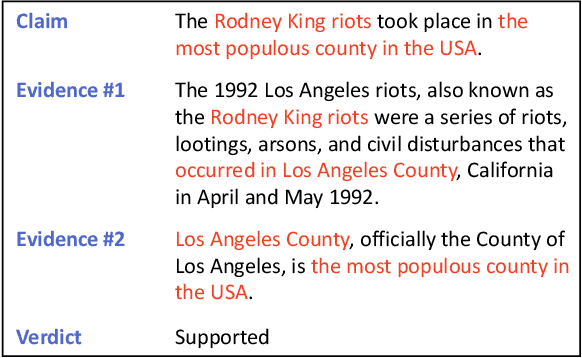

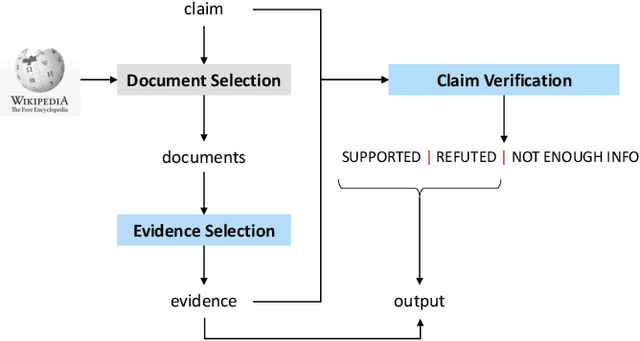
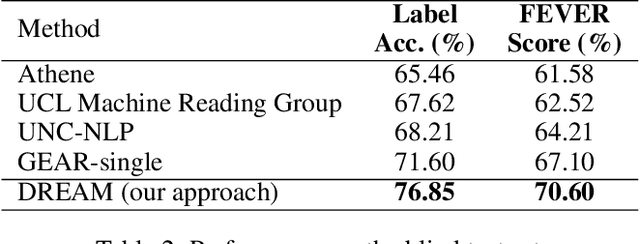
Abstract:We study fact-checking in this paper, which aims to verify a textual claim given textual evidence (e.g., retrieved sentences from Wikipedia). Existing studies typically either concatenate retrieved sentences as a single string or use feature fusion on the top of features of sentences, while ignoring semantic-level information including participants, location, and temporality of an event occurred in a sentence and relationships among multiple events. Such semantic-level information is crucial for understanding the relational structure of evidence and the deep reasoning procedure over that. In this paper, we address this issue by proposing a graph-based reasoning framework, called the Dynamic REAsoning Machine (DREAM) framework. We first construct a semantic-level graph, where nodes are extracted by semantic role labeling toolkits and are connected by inner- and inter- sentence edges. After having the automatically constructed graph, we use XLNet as the backbone of our approach and propose a graph-based contextual word representation learning module and a graph-based reasoning module to leverage the information of graphs. The first module is designed by considering a claim as a sequence, in which case we use the graph structure to re-define the relative distance of words. On top of this, we propose the second module by considering both the claim and the evidence as graphs and use a graph neural network to capture the semantic relationship at a more abstract level. We conduct experiments on FEVER, a large-scale benchmark dataset for fact-checking. Results show that both of the graph-based modules improve performance. Our system is the state-of-the-art system on the public leaderboard in terms of both accuracy and FEVER score.
A Deep Neural Information Fusion Architecture for Textual Network Embeddings
Aug 29, 2019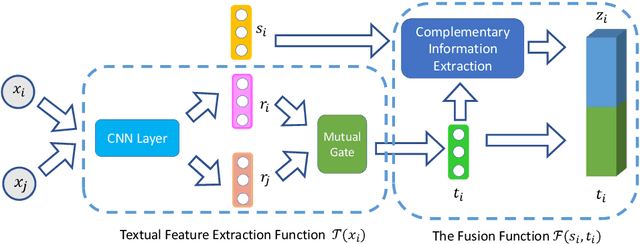
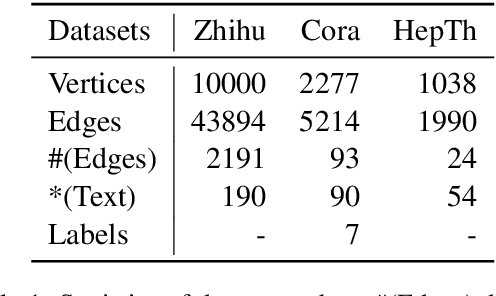
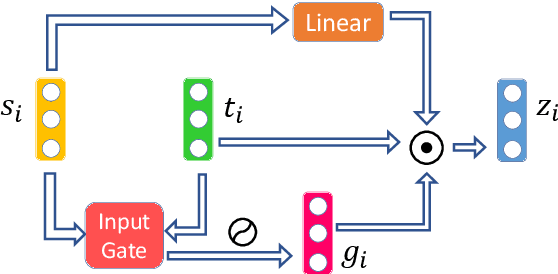
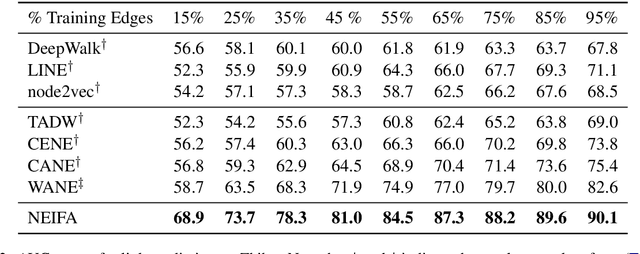
Abstract:Textual network embeddings aim to learn a low-dimensional representation for every node in the network so that both the structural and textual information from the networks can be well preserved in the representations. Traditionally, the structural and textual embeddings were learned by models that rarely take the mutual influences between them into account. In this paper, a deep neural architecture is proposed to effectively fuse the two kinds of informations into one representation. The novelties of the proposed architecture are manifested in the aspects of a newly defined objective function, the complementary information fusion method for structural and textual features, and the mutual gate mechanism for textual feature extraction. Experimental results show that the proposed model outperforms the comparing methods on all three datasets.
 Add to Chrome
Add to Chrome Add to Firefox
Add to Firefox Add to Edge
Add to Edge